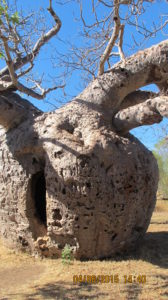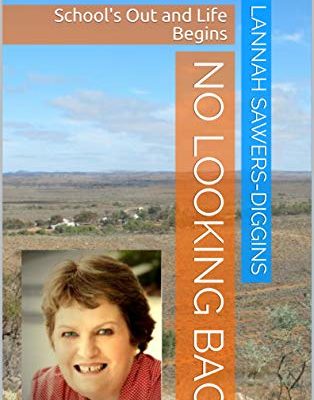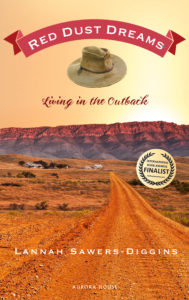Spectacular! Breathtaking! Really, no word/s adequately describe the Kimberley region of northern Western Australia. It is an area, like most of outback Australia, that I have always yearned to see – and I finally have. Some years ago, I visited the very western end of this amazing area – just enough to glimpse a taste of its true beauty. The station that I had arranged to visit was only a few kilometres east of Derby, just along the Gibb River Road and this was my first ever foray into this vast part of Western Australia.
It is an area of amazing, ancient and unique land formations. While Australia is only a relatively recent ‘discovery’, it is also one of the oldest islands in the world. There are only two climatic seasons in the Kimberley that I know of – wet and dry. The former lasts from November through to April and when it rains, it is heavy and seemingly never-ending. It doesn’t stop – not until it wants to around April in the following year. Most roads are closed simply because they are rendered impassable. There are signs at the start of all the unsealed roads out there, listing the destinations that each road leads to, then there is a little board that is moved to cover the words ‘Open’ or ‘Closed’, whichever is relevant. I also believe there are pretty heavy fines in place for those whom choose to ignore the warnings and go anyway. There are also websites which can keep people up to date before they try to head out. Tourist resorts and station stays also close. And it is my understanding that if you are anywhere ‘in there’ when the wet comes, you stay there, until the dry comes. The climate is monsoonal and cyclones are very common in the wet – this applies right across the northern parts of Australia.
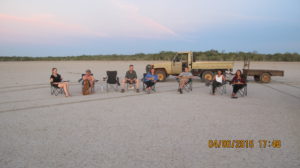
The reason for this trip was to research life on the above-mentioned station. This station participated in my book – ‘Red Dust Dreams’ and was among one of many such trips around the nation (WA., SA., NSW., Qld and the NT) visiting the 20 stations that were included in the book. The idea of this was to try to highlight the way of life of the people whom live in such remote areas of the nation. Some of the stations are hundreds of kilometres from their nearest ‘town’ which could be simply a petrol station and/or a hotel, if that. And these people survive in such conditions – and overall they love it. While it can be a very lonely and isolated existence, most of those people would not change it for anything. It is also incredibly quiet and can be viewed as relaxing, even though the people on the stations work incredibly hard. The book includes such aspects as grocery shopping, power, fuel, education, health (thank goodness for the Royal Flying Doctor Service), entertainment, holidays (what holidays???) and – well, the list is endless and includes everything that those in suburbia do. Overall, it is also usually incredibly dry out there which is why the properties are so huge and this is the reason why Victoria, the ACT and Tasmania were not included. Overall the rainfall in these states and territory is much higher which means the properties (farms) are a lot smaller and far less isolated.
Like the rest of the outback, the Kimberley did not disappoint. My daughter (who lived and worked in Broome at the time) provided the transport once I reached Broome and then she joined me on this part of the trip, which was a huge double positive. She knows the area quite well and also knew what I wanted to see so she organised a few wonderful surprises for me. The first was visiting the prison Boab Tree at the western end of the Gibb River Road (there is also one at the eastern end, so I understand). The one we saw is absolutely mammoth, believed to be around 1,500 years old. I say mammoth because apparently it has a circumference of some fourteen centimetres. It also has a door (two metres by one metre) and was called the Prison Tree for a reason – it is my understanding that in the 1890s it was used by local police to hold Aboriginal people overnight. There are information boards at the entrance, describing the story behind it as well as providing photos. I found this all to be fascinating – but also incredibly sad. I seem to recall that the tree was also used by the Aboriginal people for shelter, food and medicinal purposes. Unique to the region, these trees are thought to originate from some millions of years ago when Africa and Australia were joined. 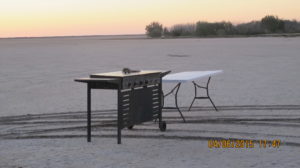
We also dropped in to the Mowanjum Aboriginal Art and Culture Centre. Those people are so clever and talented. Some superb pieces of art there – actually all the pieces I saw were beautiful. I have also heard that each piece of art holds a story – I would love to know more about that.
Our whole trip to the Kimberley was great fun and so interesting. We even went camping (invited by the manager of the station) – something I had not done for X amount of years and was a tad apprehensive about the very idea of this. But…off we went…and had the best time. The tent was just a ‘bit’ improved on the last one I had slept in. And the food – wow. The station cook joined us on the camp and treated us to an amazing meal which consisted of two different sorts of sausages, several salads and finished with a Nutella Cheesecake! Now, this was MY kind of meal. We camped on a dry salt marsh not far from the station and we could see the lights of Derby twinkling in the distance – on the other side of the marsh. The rooves of our tents were made of clear plastic – pure bliss to just lie back and take in the beautiful night sky. So clear – you could almost reach out and touch those stars. Just superb.
After dinner, Rob joined an impromptu fun fire-building competition. What a laugh. AND I will add that it was completely safe there – no wind at all to carry any alien little sparks off to potentially start new fires and the marsh is absolutely enormous. I think we had five healthy fires burning at one stage, all except one were completely put out by the time we all went to bed. That one fizzled out safely during the night. So much fun.
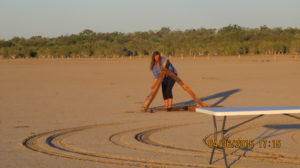
An early morning start next day and several new sets of tracks around the tents indicated we had had visitors during the night. Never did find out exactly what (they looked like dogs…) and not in a hurry to find out. When cleaning up and taking down tents, one of the staff discovered another visitor – under his mattress. A small python. Ok! After we’d all crowded around for a good look and after many photos, one of the other staff picked up the snake, which was probably terrified and took it into the scrub at the edge of the pan and left it there.
And on the way to and from the salt marsh, we passed another homestead which was deserted but it was explained to us that it was actually Bungarun, which was an old leprosarium, constructed in 1936 and closed in 1986 and was mainly for Aboriginal sufferers of the disease. My understanding is that, sadly, 357 of them did not survive and are buried locally in simple graves with white crosses. There are quite a few buildings remaining: quarters for former medical staff, dormitories, service buildings, patients’ shelters and an Anglican chapel which was constructed in 1956. This is listed as an Aboriginal Heritage Site and was placed in the Register of Historic Places in 2000. I really wanted to go inside and have a good look – but not alone – not even if I was paid to. I cannot get enough of deserted buildings and ruins and the histories behind them. But this one just looked…odd, to me. But that only made it more fascinating.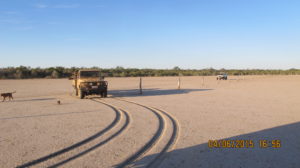
As mentioned above, my daughter had arranged some surprises for me for after our stay at the station. The first of these was a visit to the spectacular Windjana Gorge which cuts through the Napier Range which is all part of the ancient Devonian Limestone Reef. And I finally – FINALLY – saw freshwater crocodiles in the wild. I could not believe it – but there they were, about 10 ‘freshies’ all basking in the sun. Real, live crocodiles. And they were not interested in us at all.
Next stop – Tunnel Creek. Wow. This also cuts through the Napier Range. Equally amazing and quite the challenge to climb down through many very large rocks, plunging yourself into complete darkness. It is advised that you wear ‘appropriate’ shoes for this walk as you do go over many uneven rocks and all sorts of other things, probably as well as walking through a lot of water. There are also ‘freshies’ in there – we did see a pair of eyes glinting at us from the sidelines at one stage but I spied another mammoth Huntsman perched on top of a rock in the water – quite near the croc so I was trying to watch both at the same time. We did wear those miner-cap things with a light on them, so we could see our way – sortof. It was quite a long walk and an absolutely wonderful one. Have no idea how long we took. After we found our way back to my daughter’s car there was another surprise awaiting me – she had had the forethought to bring a picnic lunch for us. Yum. 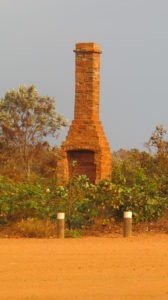
Legend has it that Tunnel Creek was used as a hide-out by the Aboriginal leader, Jandamarra, who was eventually killed outside its entrance in 1897. It is well worth a visit – as long as you are prepared.
Time was moving on so we realised we needed to get moving if we were to reach Broome by sunset. My daughter was doing all the driving and was getting tired, understandbly. On our way to the main road west, we called in at the ruins of an old police station – Lillimulura – the story behind these also concerns Jandamarra and was equally fascinating. And a old mine site, if I remember correctly.
This trip was actually the second to last of my research trips for the book. I was very sorry when it was all over and all it has really done is to whet my appetite for further trips into our mighty outback.
